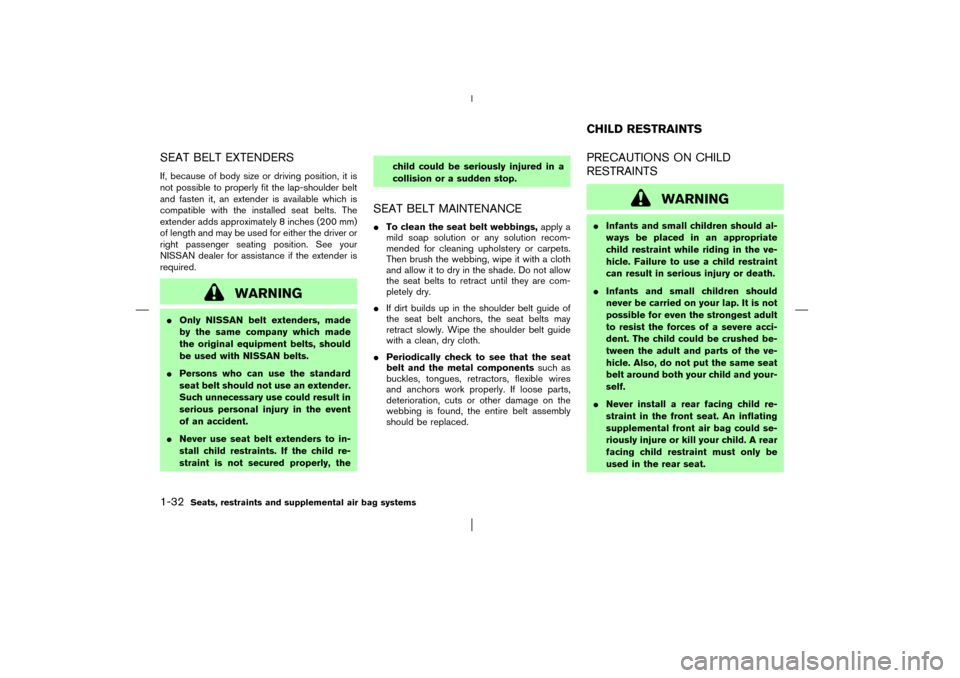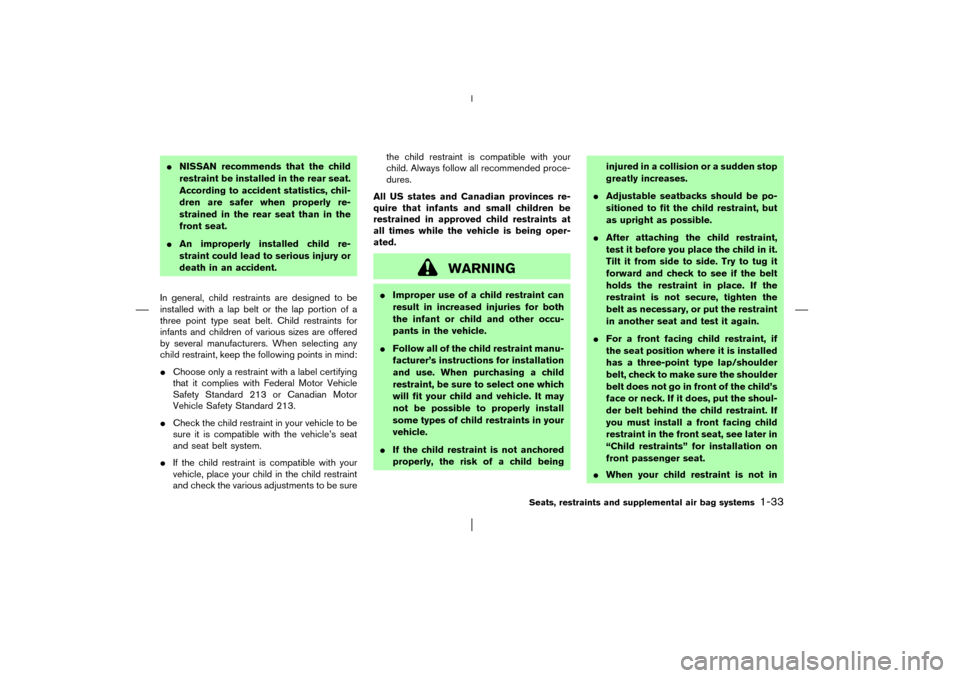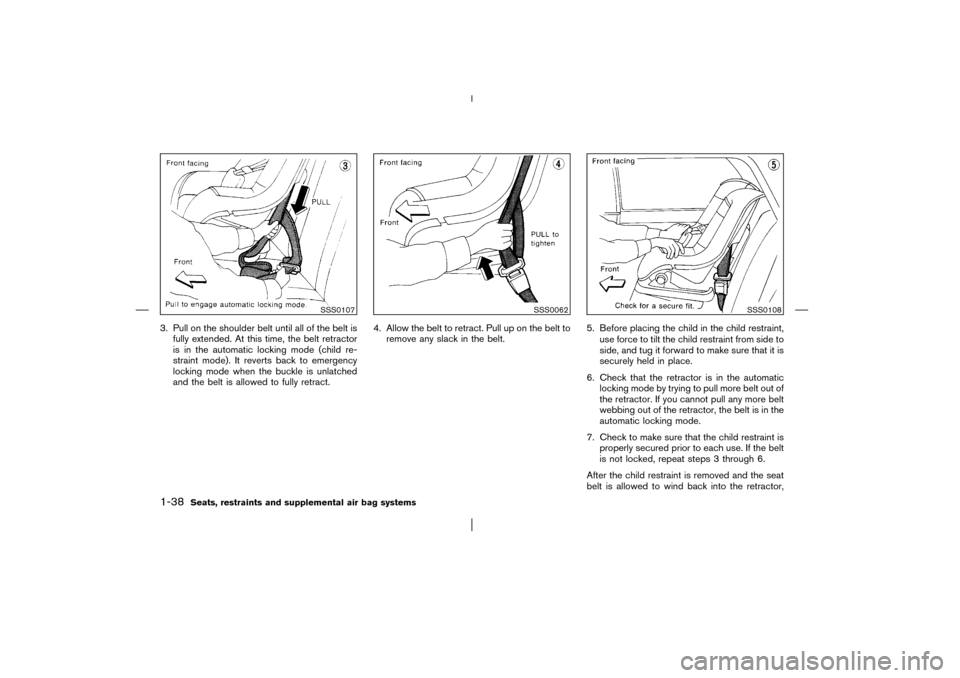Page 39 of 299

SEAT BELT EXTENDERSIf, because of body size or driving position, it is
not possible to properly fit the lap-shoulder belt
and fasten it, an extender is available which is
compatible with the installed seat belts. The
extender adds approximately 8 inches (200 mm)
of length and may be used for either the driver or
right passenger seating position. See your
NISSAN dealer for assistance if the extender is
required.
WARNING
�Only NISSAN belt extenders, made
by the same company which made
the original equipment belts, should
be used with NISSAN belts.
�Persons who can use the standard
seat belt should not use an extender.
Such unnecessary use could result in
serious personal injury in the event
of an accident.
�Never use seat belt extenders to in-
stall child restraints. If the child re-
straint is not secured properly, thechild could be seriously injured in a
collision or a sudden stop.
SEAT BELT MAINTENANCE�To clean the seat belt webbings,apply a
mild soap solution or any solution recom-
mended for cleaning upholstery or carpets.
Then brush the webbing, wipe it with a cloth
and allow it to dry in the shade. Do not allow
the seat belts to retract until they are com-
pletely dry.
�If dirt builds up in the shoulder belt guide of
the seat belt anchors, the seat belts may
retract slowly. Wipe the shoulder belt guide
with a clean, dry cloth.
�Periodically check to see that the seat
belt and the metal componentssuch as
buckles, tongues, retractors, flexible wires
and anchors work properly. If loose parts,
deterioration, cuts or other damage on the
webbing is found, the entire belt assembly
should be replaced.
PRECAUTIONS ON CHILD
RESTRAINTS
WARNING
�Infants and small children should al-
ways be placed in an appropriate
child restraint while riding in the ve-
hicle. Failure to use a child restraint
can result in serious injury or death.
�Infants and small children should
never be carried on your lap. It is not
possible for even the strongest adult
to resist the forces of a severe acci-
dent. The child could be crushed be-
tween the adult and parts of the ve-
hicle. Also, do not put the same seat
belt around both your child and your-
self.
�Never install a rear facing child re-
straint in the front seat. An inflating
supplemental front air bag could se-
riously injure or kill your child. A rear
facing child restraint must only be
used in the rear seat.CHILD RESTRAINTS
1-32
Seats, restraints and supplemental air bag systems
�
03.1.28/R50-D/V5
�
Page 40 of 299

�NISSAN recommends that the child
restraint be installed in the rear seat.
According to accident statistics, chil-
dren are safer when properly re-
strained in the rear seat than in the
front seat.
�An improperly installed child re-
straint could lead to serious injury or
death in an accident.
In general, child restraints are designed to be
installed with a lap belt or the lap portion of a
three point type seat belt. Child restraints for
infants and children of various sizes are offered
by several manufacturers. When selecting any
child restraint, keep the following points in mind:
�Choose only a restraint with a label certifying
that it complies with Federal Motor Vehicle
Safety Standard 213 or Canadian Motor
Vehicle Safety Standard 213.
�Check the child restraint in your vehicle to be
sure it is compatible with the vehicle’s seat
and seat belt system.
�If the child restraint is compatible with your
vehicle, place your child in the child restraint
and check the various adjustments to be surethe child restraint is compatible with your
child. Always follow all recommended proce-
dures.
All US states and Canadian provinces re-
quire that infants and small children be
restrained in approved child restraints at
all times while the vehicle is being oper-
ated.
WARNING
�Improper use of a child restraint can
result in increased injuries for both
the infant or child and other occu-
pants in the vehicle.
�Follow all of the child restraint manu-
facturer’s instructions for installation
and use. When purchasing a child
restraint, be sure to select one which
will fit your child and vehicle. It may
not be possible to properly install
some types of child restraints in your
vehicle.
�If the child restraint is not anchored
properly, the risk of a child beinginjured in a collision or a sudden stop
greatly increases.
�Adjustable seatbacks should be po-
sitioned to fit the child restraint, but
as upright as possible.
�After attaching the child restraint,
test it before you place the child in it.
Tilt it from side to side. Try to tug it
forward and check to see if the belt
holds the restraint in place. If the
restraint is not secure, tighten the
belt as necessary, or put the restraint
in another seat and test it again.
�For a front facing child restraint, if
the seat position where it is installed
has a three-point type lap/shoulder
belt, check to make sure the shoulder
belt does not go in front of the child’s
face or neck. If it does, put the shoul-
der belt behind the child restraint. If
you must install a front facing child
restraint in the front seat, see later in
“Child restraints” for installation on
front passenger seat.
�When your child restraint is not in
Seats, restraints and supplemental air bag systems
1-33
�
03.1.28/R50-D/V5
�
Page 41 of 299
use, store it in the trunk or keep it
secured with a seat belt to prevent it
from being thrown around in case of
a sudden stop or accident.
CAUTION
Remember that a child restraint left in a
closed vehicle can become very hot.
Check the seating surface and buckles
before placing your child in the child
restraint.
INSTALLATION ON REAR SEAT
CENTER POSITION
Front facingWhen you install a child restraint in a rear center
seat, follow these steps:
1. Position the child restraint on the seat as
illustrated. The direction of the child restraint
depends on the type of the child restraint and
the size of the child. Always follow the re-
straint manufacturer’s instructions.2. Route the seat belt tongue through the child
restraint and insert it into the buckle until you
hear and feel the latch engage. Be sure to
follow the child restraint manufacturer’s in-
structions for belt routing.
SSS0104
SSS0029
1-34
Seats, restraints and supplemental air bag systems
�
03.1.28/R50-D/V5
�
Page 42 of 299
3. Remove all slack in the lap belt for a very tight
fit by pulling forcefully on the lap belt adjust-
ment.4. Before placing the child in the child restraint,
use force to tilt the child restraint from side to
side, and tug it forward to make sure that it is
securely held in place.
5. If it is not secure, try to tighten the belt again,
or put the restraint in another seat.
6. Check to make sure the child restraint is
properly secured prior to each use.
Rear facingWhen you install a child restraint in a rear center
seat, follow these steps:
1. Position the child restraint on the seat as
illustrated. The direction of the child restraint
depends on the type of the child restraint and
the size of the child. Always follow the re-
straint manufacturer’s instructions.
SSS0105
SSS0031
SSS0033
Seats, restraints and supplemental air bag systems
1-35
�
03.1.28/R50-D/V5
�
Page 43 of 299
2. Route the seat belt tongue through the child
restraint and insert it into the buckle until you
hear and feel the latch engage. Be sure to
follow the child restraint manufacturer’s in-
structions for belt routing.3. Remove all slack in the lap belt for a very tight
fit by pulling forcefully on the lap belt adjust-
ment.4. Before placing the child in the child restraint,
use force to tilt the child restraint from side to
side, and tug it forward to make sure that it is
securely held in place.
5. If it is not secure, try to tighten the belt again,
or put the restraint in another seat.
6. Check to make sure the child restraint is
properly secured prior to each use.
SSS0035
SSS0036
SSS0106
1-36
Seats, restraints and supplemental air bag systems
�
03.1.28/R50-D/V5
�
Page 44 of 299

INSTALLATION ON REAR SEAT
OUTBOARD POSITIONS
Front facing
WARNING
�The three-point belt on your vehicle
is equipped with a locking mode re-
tractor which must be used when
installing a child restraint.
�Failure to do so will result in the childrestraint not being properly secured.
It could tip over or otherwise be un-
secured and cause injury to the child
in a sudden stop or collision.
When you install a child restraint in a rear
outboard seat, follow these steps:
1. Position the child restraint on the seat. The
direction of the child restraint depends on the
type of the child restraint and the size of the
child. Always follow the restraint manufactur-
er’s instructions.
2. Route the seat belt tongue through the child
restraint and insert it into the buckle until you
hear and feel the latch engage.
Be sure to follow the child restraint manufac-
turer’s instructions for belt routing.
SSS0041
SSS0043
Seats, restraints and supplemental air bag systems
1-37
�
03.1.28/R50-D/V5
�
Page 45 of 299

3. Pull on the shoulder belt until all of the belt is
fully extended. At this time, the belt retractor
is in the automatic locking mode (child re-
straint mode). It reverts back to emergency
locking mode when the buckle is unlatched
and the belt is allowed to fully retract.4. Allow the belt to retract. Pull up on the belt to
remove any slack in the belt.5. Before placing the child in the child restraint,
use force to tilt the child restraint from side to
side, and tug it forward to make sure that it is
securely held in place.
6. Check that the retractor is in the automatic
locking mode by trying to pull more belt out of
the retractor. If you cannot pull any more belt
webbing out of the retractor, the belt is in the
automatic locking mode.
7. Check to make sure that the child restraint is
properly secured prior to each use. If the belt
is not locked, repeat steps 3 through 6.
After the child restraint is removed and the seat
belt is allowed to wind back into the retractor,
SSS0107
SSS0062
SSS0108
1-38
Seats, restraints and supplemental air bag systems
�
03.1.28/R50-D/V5
�
Page 46 of 299
the automatic locking mode (child restraint
mode) is canceled; the seat belt only locks
during a sudden stop or impact.
Rear facing
WARNING
�The three-point belt on your vehicle
is equipped with a locking mode re-
tractor which must be used when
installing a child restraint.
�Failure to do so will result in the child
restraint not being properly secured.
It could tip over or otherwise be un-
secured and cause injury to the childin a sudden stop or collision.
When you install a child restraint in a rear
outboard seat, follow these steps:
1. Position the child restraint on the seat. The
direction of the child restraint depends on the
type of the child restraint and the size of the
child. Always follow the restraint manufactur-
er’s instructions.
SSS0044Seats, restraints and supplemental air bag systems
1-39
�
03.1.28/R50-D/V5
�